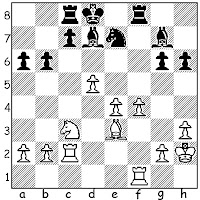
Sometimes I visit the GameKnot.com chess site and pick up a Jerome Gambit (1.e4 e5 2.Nf3 Nc6 3.Bc4 Bc5 4.Bxf7+) game or two. (I would collect more, using their Games Database feature, but I am not a regular member.) The following one is a few years old, but it has the typical Jerome je ne sais quoi that sets it apart from other contests.
surfingscotty - arif__khan
GameKnot,com, 2012
1.e4 e5 2.Nf3 Nc6 3.Bc4 Bc5 4.Bxf7+
4...Kxf7 5.Nxe5+ Nxe5 6.d4 Ne7
Black's idea is familiar, even if it shows up in only a few games in The Database: If he has to give back a piece, don't waste time deciding on which on, just develop another.
7.Qh5+
A bit better is probably 7.dxc5 as seen in a couple of games: 7...Re8 (7...Rf8 8.Qh5+ N5g6 9.Qxh7 Rh8 10.Qxh8 Qxh8 11.O-O d6
12.cxd6 cxd6 13.Bg5 Be6 14.f4 Bc4 15.Rd1 Rd8 16.b3 Qh5 17.Nd2 Be2 18.Re1 Rh8 19.h3 Ba6 20.c4 Nc6 21.Nf3 b5 22.h4 bxc4 23.b4 Nxb4 White resigned, paoloumali - regnarkragh, FICS, 2011) 8.Qh5+ N7g6 9.Qf5+ Qf6 10.Qh3 Kg8 11.Qb3+ Kh8 12.Nc3 Ng4 13.Be3 Nxe3 14.fxe3 Qg5 15.O-O-O Qxe3+ 16.Kb1 b6 17.Rhe1 Qxc5 18.Nd5 c6 19.Ne3 Ne5 20.Nf5 Re6 21.Rf1 Ba6 22.Rf4 Bc4 23.Qg3 Rg6 24.Qh3 Rd8 25.Rh4 Bg8 26.Rf1 Nf7 27.Rg4 Ng5 28.Qd3 Bc4 29.Qd2 Bxf1 30.b3 d5 31.Rxg5 Rxg5 32.Qxg5 Qf8 33.Nxg7 Qxg7 34.Qxd8+ Qg8 35.Qf6+ Qg7 36.Qxf1 h6 37.exd5 cxd5 38.a4 Kh7 39.Qd3+ Kh8 40.Qxd5 Qg8 41.Qe5+ Qg7 42.Qb8+ Kh7 43.g3 h5 44.h4 Qxg3 45.Qxg3 Black resigned, HauntedKnight - dukifanto. FICS, 2012.
Also seen was 7.dxe5 Rf8 8.Nc3 Kg8 9.O-O Ng6 10.Qd5+ Kh8 11.Qxc5 d6 12.exd6 cxd6 13.Qe3 Qf6 14.Nd5 Qe7 15.Nxe7 Nxe7 16.f4 h6 17.e5 dxe5 18.Qxe5 Nc6 19.Qd6 Bg4 20.Qg6 Bf5 21.Qg3 Nd4 22.Qf2 Nxc2 White forfeited on time, stretto - svadali, FICS, 2008.
7...N7g6 8.dxc5 d6 9.f4
A standard "tool" from White's "toolbox", although Stockfish 7 suggests development with 9.h3 Re8 10.O-O Kg8 11.Nc3 b6 12.Bg5 Qd7 13.cxd6 Ba6 14.Rfd1 cxd6 first, then 15.f4.
In the game, Black is able to force an exchange of Queens when White does not have enough dynamic pawn play in the middle game to balance the sacrificed piece. The attacker will develop, castle, and begin to pressure his opponent, but he will need some help to prevail - and, oddly, he receives it.
9...Bg4 10.Qg5 Qxg5 11.fxg5 dxc5 12.Nc3 c6 13.O-O+ Ke7 14.h3 Be6 15.Be3 b6 16.Ne2 Nc4
Here Black resigned after playing his move. I don't know why. Most likely the real world intervened, and he needed to return there.

















